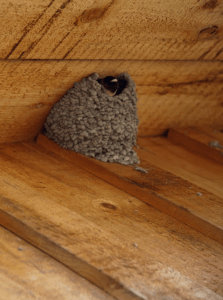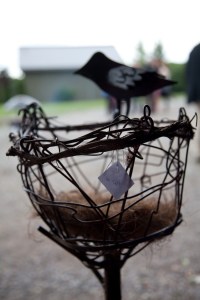

As we restored the barn, I had no problem getting rid of stray nails and rotten boards. What I couldn’t get rid of was the population of pigeons, swallows and other birds.
The doors were on, the windows installed, and all the holes — the big ones, anyway — were filled in. Surely the birds were gone for good? Well, no. But we’ve managed to find a way to coexist.
The turning point was the day that Nim, the white dog whose role was supposed to involve protecting the goats, snatched a baby pigeon up in his mouth, leaving its twin alone in the nest with no sibling or mother. I know I probably should have just let nature take its course, but the next thing I knew, I had the baby in a cage, nursing it back to health. Great.
I finally admitted to myself that I couldn’t face the potential dislocation of all of those poor birds. We opened the doors on the bottom part of the barn just a little bit and overnight, the swallows (and a few pigeons) moved in.
I’m so glad I went with my heart — it’s been truly amazing to watch and listen to the barn coming alive with birds. I’ve been richly rewarded with the sounds of their singing and chirping, not to mention the fact that they eat their weight in bugs.
We’ve reached a compromise. The birds get the bottom part of the barn. My guests get the top part. The swallows no longer try to invade our territory, and we try not to interfere with them.
I was reminded of my feathered follies recently at the recent open house I held to introduce people to South Pond Farms and see if there was interest in the food- and art-related courses and products I’m offering.

Visitors wandered the grounds, checking out the goat palace, the freshly stocked South Pond Store and of course the barn. It gave me such pleasure to see people strolling about, meeting new friends and hailing old ones despite the chill in the air.
But I think the highlight of the evening for me was seeing guests transfixed by the sight of baby swallows peeking out of their brilliantly engineered mud nests as their moms and dads swooped around to make sure all was well.
The sight made me realize that the barn is truly coming into its own. This is what I was aiming for, even if I wasn’t conscious of it — nature’s beauty and human function in harmony. And after all, a barn is for livestock, even if it’s the singing, feathered kind.
Sign up to receive stories and updates
You may also enjoy